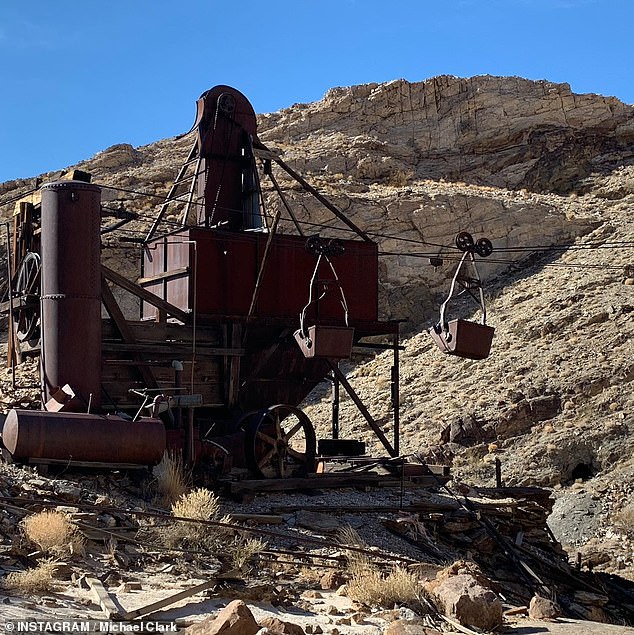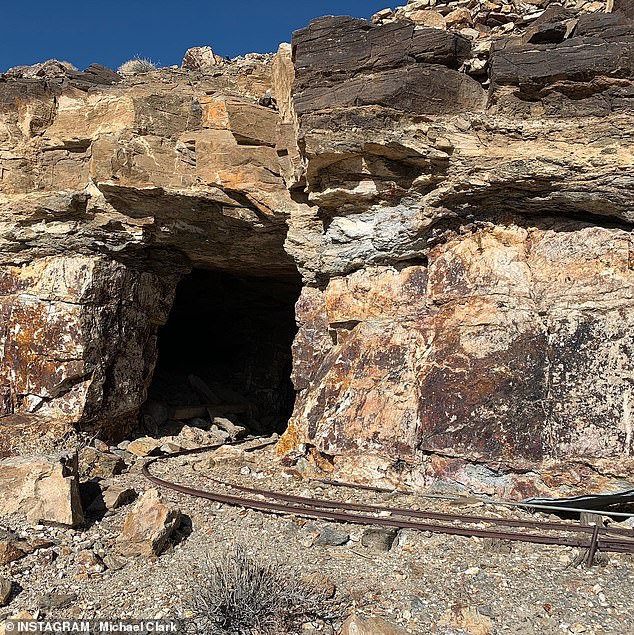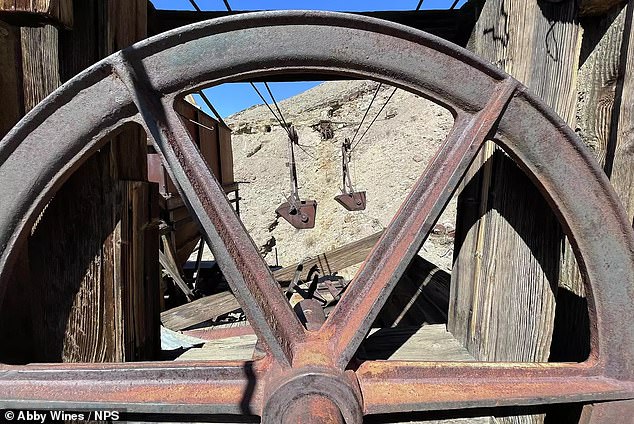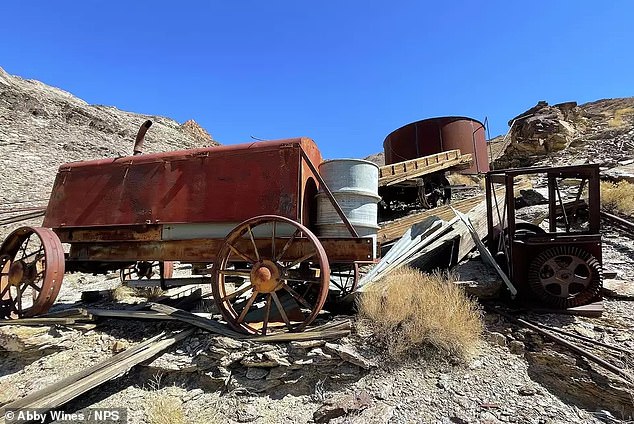A “ghost mine” in Death Valley, California, remains stuck in the past, with old bullet holes in houses and rocks piled up outside a California gold rush quarry.
The Big Bell mine, abandoned since 1941, is only visited by a handful of people each year because its location is practically inaccessible and there are almost no signs to guide the few tourists.
But the remoteness of the 10-acre mine has proven to be its saving grace. Founded in 1904, the Great Bell is untouched by time and offers visitors a window into an America that has long since ceased to exist.
The rusting ore containers that once whizzed out of the bowels of the mine, laden with gold ore, still hang from cables, as if in full motion.
The footprints, made more than a hundred years ago, are still rooted in the rocky land.

The ore buckets, pictured, are just one example of the Big Bell Mine equipment that still survives, as if still in use.


The tracks (pictured) leading to the mine where prospectors once worked in the sweltering heat of Death Valley.
It was along these same routes that miners and prospectors, hoping to find money, were transported in and out of the mine.
The ramshackle shacks in which the workers lived and the moth-eaten cots in which they slept also dot the grounds.
The mine is located at the foot of Chloride Cliff. To reach the mine, you must traverse 1.7 miles of treacherous terrain and endure 1,600 feet of elevation change.
The trip requires a high-clearance vehicle, good navigation skills and providential weather conditions.
It also requires a sense of daring, a sense of daring similar to that possessed by the prospectors who once worked in the mine below.
A steep path, flanked by iron stakes that once helped transport ore and miners uphill, descends to the mine. The trailhead is marked by a water tank dotted with bullet holes.
The mine is beyond the reach of civilization. And time.
The Big Bell Mine was originally claimed by John Cyty, a irascible 5-foot-tall prospector with a penchant for risk in 1904.
Cyty claimed the Big Bell due to its proximity to the Keane Wonder mine, a high-yield site.
He grabbed hundreds of shares of Big Bell, and with the mining business booming, Cyty had plenty of cash.
The prospector invested his money in a dance hall in Rhyolite, where miners looking for a little respite from their grueling work could spend their wages to see the women perform.
But Cyty ran afoul of locals because it employed non-union women’s dances, a move that frustrated unionized women as well as nearby mining unions.
They boycotted the ballroom and Cyty’s finances declined until he was finally evicted from the ballroom.
Ever defiant, the seeker stormed the ballroom, where he was arrested.
Then the boom broke: a nationwide financial panic destroyed the area’s mining business.
Cyty’s stock value plummeted from 30 cents per share to just 4 cents. The bankruptcy prevented further investment in Big Bell.
The following year, Cyty, true to his reckless and intrepid character, bet the mine in a room aptly called the Stock Market.


The mine was first claimed by John Cyty in 1904. A few years later, the rogue miner would bet his shares in the mine in a game of roulette.
No doubt desperate, the prospector had bet 250,000 shares of the mine in a game of roulette with the tavern owner.
When Cyty left the room 12 hours later, he had sold every last share of Big Bell stock, which was estimated to be worth $10,000.
In 1908, the Los Angeles Herald called Cyty’s loss at roulette “unparalleled in the history of the state.”
Unstoppable, Cyty created a new claim called Big Bell Extension, which is close to Big Bell and also features pristine ruins.
But a rival search engine, C. Kyle Smith, disputed Cyty’s claim.
Cyty responded by telling Smith that if he appeared in his claim, he would kill him.
In November 1908, Smith showed up at the claim and showed up armed.
Gunfire erupted. Cyty shot Smith in the leg and stomach, wounds that would prove fatal.
Smith died and Cyty was jailed for involuntary manslaughter. He served a year and a half of his ten-year sentence, before being retried, acquitted and then released.
Cyty returned to Big Bell Extension, where he had built a mill and cabin, but became restless, gave up mining, and moved on.
His mill and cabin still stand.
The Coen Company took over the Big Bell Mine in 1936, hoping to build up the site and give it some life.
The inaccessibility of the mine, as well as poor terrain and a shortage of precious metals, made the venture unviable.
Before the year was out, the Coen Company abandoned the site.
But the mine still exists, still emerging from the earth as if it were still in operation.


Due to the isolation of the mine and the dangerous journey that the visitor must make to get there, the place remains perfectly preserved. No historical society or park foundation has had to intervene to maintain it
The equipment, although rusty, is still there, untouched by potential scavengers because it is so remote.
speaking to SF gateJeremy Stoltzfus of the Death Valley Abandoned Mine Lands Program explained how the mine has not required outside help for its preservation.
“The park hasn’t done anything there,” Stoltzfus said.
“Big Bell has been virtually untouched since the miners last left.”

